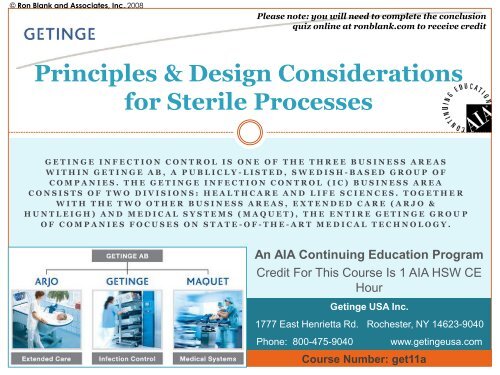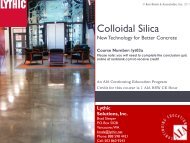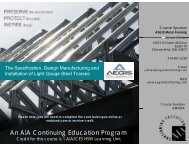Principles & Design Considerations for Sterile Processes
Principles & Design Considerations for Sterile Processes
Principles & Design Considerations for Sterile Processes
- No tags were found...
You also want an ePaper? Increase the reach of your titles
YUMPU automatically turns print PDFs into web optimized ePapers that Google loves.
© Ron Blank and Associates, Inc.® 2008Please note: you will need to complete the conclusionquiz online at ronblank.com to receive credit<strong>Principles</strong> & <strong>Design</strong> <strong>Considerations</strong><strong>for</strong> <strong>Sterile</strong> <strong>Processes</strong>G E T I N G E I N F E C T I O N C O N T R O L I S O N E O F T H E T H R E E B U S I N E S S A R E A SW I T H I N G E T I N G E A B , A P U B L I C L Y - L I S T E D , S W E D I S H - B A S E D G R O U P O FC O M P A N I E S . T H E G E T I N G E I N F E C T I O N C O N T R O L ( I C ) B U S I N E S S A R E AC O N S I S T S O F T W O D I V I S I O N S : H E A L T H C A R E A N D L I F E S C I E N C E S . T O G E T H E RW I T H T H E T W O O T H E R B U S I N E S S A R E A S , E X T E N D E D C A R E ( A R J O &H U N T L E I G H ) A N D M E D I C A L S Y S T E M S ( M A Q U E T ) , T H E E N T I R E G E T I N G E G R O U PO F C O M P A N I E S F O C U S E S O N S T A T E - OF- THE- A R T M E D I C A L T E C H N O L O G Y .An AIA Continuing Education ProgramCredit For This Course Is 1 AIA HSW CEHourGetinge USA Inc.1777 East Henrietta Rd. Rochester, NY 14623-9040Phone: 800-475-9040www.getingeusa.comCourse Number: get11a
An American Institute of Architects (AIA)Continuing Education programApproved Promotional Statement:Ron Blank & Associates, Inc. is a registered provider with The American Institute ofArchitects Continuing Education System. Credit earned upon completion of thisprogram will be reported to CES Records <strong>for</strong> AIA members. Certificates ofCompletion are available <strong>for</strong> all course participants upon completion of the courseconclusion quiz with +80%.Please view the following slide <strong>for</strong> more in<strong>for</strong>mation on Certificates of Completion through RBAThis program is registered with the AIA/CES <strong>for</strong> continuing professionaleducation. As such, it does not include content that may be deemed orconstrued to be an approval or endorsement by the AIA or Ron Blank &Associates, Inc. of any material of construction or any method or mannerof handling, using, distributing, or dealing in any material or product.
An American Institute of Architects (AIA)Continuing Education programCourse Format: This is a structured, web-based, self study course with a final exam.Course Credit: 1 AIA Health Safety & Welfare (HSW) CE HourCompletion Certificate: A confirmation is sent to you by email and you can print oneupon successful completion of a course or from your RonBlank.com transcript. If youhave any difficulties printing or receiving your Certificate please send requests tocertificate@ronblank.com<strong>Design</strong> professionals, please remember to print or save yourcertificate of completion after successfully completing a courseconclusion quiz. Email confirmations will be sent to the emailaddress you have provided in your RonBlank.com account.Please note: you will need to complete the conclusion quiz online at ronblank.com to receive credit
Course DescriptionBe able to describe why the sterile processingdepartment is important, and the concepts ofdecontamination and sterilization. Identify the type ofequipment found in the SPD, and understand theworkflow and factors to consider when designing a SPD.
Course ObjectivesUpon Completion of this course the participants will be able to:• Explain why the <strong>Sterile</strong> Processing Department (SPD) is such animportant and integral part of a facility where sterility is paramount• Comprehend the basic concepts of decontamination and sterilization• Identify the type of equipment found in the SPD• Be familiar with the workflow of SPD• List factors to consider when designing a SPD
The <strong>Sterile</strong> ProcessingDepartment (SPD)W H A T I S T H E V A L U E O F T H E S P D I N A F A C I L I T Y ?W O R K F L O W O F T H E S T E R I L E P R O C E S S I N G D E P A R T M E N TD E C O N T A M I N A T I O N : C L E A N I N G & D R Y I N GW H A T I S :T H E D E C O N T A M I N A T I O N P R O C E S S ?P R E P & P A C K ?S T E R I L I Z A T I O N ?S T E R I L E S T O R A G E ?
IntroductionWhat are some of the differences between ahospital and a hotel?• They both want a nice entrance, friendly and calmingenvironments, and return visits.• They also have individual guest rooms with attached bathrooms.• Hospitals typically do not have pools, but many have whirlpools<strong>for</strong> expectant mothers in the LDRP.• The biggest difference is the role that sterile processing plays inthe health of patients, employees, and the building. Without it,surgeries would be much more dangerous, with lastingdebilitating results and effects.The <strong>Sterile</strong> Processing Department
Workflow of the <strong>Sterile</strong> Processing DepartmentThe shown 3-D diagram on the following slide is a representation of asterile processing department. This example is a new trend in the U.S.market that has become a standard in Europe. They divide each of thecleaning stages into separate zones. Typically in the United States wesee the packing department in the same area as the sterilization room.A fourth area that in shown in this diagram is the sterile storage andstaging area. Here materials and instruments are pulled, packed, andorganized onto carts <strong>for</strong> specific scheduled operations.The <strong>Sterile</strong> Processing Department
Workflow of the <strong>Sterile</strong> Processing Department<strong>Sterile</strong>StorageSterilizationPrep and PackSoiled ReturnDecontaminationThe <strong>Sterile</strong> Processing Department
Workflow of the <strong>Sterile</strong> Processing Department• Note the separating walls <strong>for</strong> each of the above areas.• During the course of this presentation: A red floor will designate thedecontamination/dirty area. Blue will represent the prep/pack areaand green will be <strong>for</strong> sterilization and sterile storage.• In some of the larger hospitals in the U.S. a 3 zone department isbeing established because of itsuni-directional flow, cutting down on the possibility of crosscontamination.• We are going to step through the SPD starting in the Disinfectionarea.The <strong>Sterile</strong> Processing Department
What is the Decontamination Process?So what is decontamination?Here is the definition as provided by OSHA:“The use of physical or chemical means to remove, inactivate ordestroy blood borne pathogens on a surface or item to the point wherethey are no longer capable of transmitting infectious particles and thesurface or item is safe <strong>for</strong> handling, use or disposal.”(OSHA CFR 1910.1030)The <strong>Sterile</strong> Processing Department
What is the Decontamination Process?• In the surgical environment hospitals must be very cognizant of alltypes of contamination. This does not only include dust, lint, paintchips, metal shavings, hair, but also microscopic soils that are invisibleto the eye that can and will cause infection in the surgical incision.• There<strong>for</strong>e, what types of soils on surgical instrumentation are weremoving? First are the organics, mainly comprised of blood, tissue,fats, feces, grease, and proteins. Second are the inorganics such aswater deposits – lime, rust and types of scale. Each of these can causeand infection in a surgical wound leading to more seriouscomplications.The <strong>Sterile</strong> Processing Department
Decontamination Cleaning & DryingAutomated CleaningManual Cleaning• The washer disinfector renders itsload (i.e. washed goods, surgicalinstruments, etc.) safe to handle• Disinfection and cleaning of noncriticalgoods prevents hospitalacquired infections• Staff safety-cleaning process takesplace in a closed chamber whichmeans no risk <strong>for</strong> splashes andthereby contamination• Correct drying after cleaning caneasily be arranged and integratedinto the process• No automated disinfection ofinstruments and utensils, increasesthe risk of contaminations andinfections.• Contamination risk <strong>for</strong> staff due toexposure to soil and liquids.• Wet goods may causere-contaminationThe <strong>Sterile</strong> Processing Department
What is Prep & Pack?• Today most sterilizers can be found in the prep/pack room, but asmentioned be<strong>for</strong>e, this trend is changing. You can think of this area asbeing the ‘clean room’.• During a typical site visit, you as the visitor would ‘gown-up’ and enterthe prep/pack area first. Why would this be?The <strong>Sterile</strong> Processing Department
What is Prep & Pack?• The main reason is to eliminate the possibility of cross contamination.If you were to enter via the ‘dirty’ decontamination door then into theprep/pack the hospital runs the risk of you carrying a potential ‘bug’with you that could invade, attach, or contaminate a disinfected orsterilized instrument.• The professionals in prep and pack must pay close attention to details.Each instrument must be visually examined <strong>for</strong> quality. They mustcheck surfaces <strong>for</strong> remaining soils, determine if the instrument isfunctioning properly – does it need sharpening? is it bent? is it wornand needs to be replaced? insure that instrument sets and trays areassembled, wrapped and placed into the sterilizers correctly, catalogueand pull instruments, track and trace instruments and sets, and verifythe sterilizers per<strong>for</strong>med their cycles correctly each and every time.The <strong>Sterile</strong> Processing Department
What is Sterilization?Let’s ask these questions of ourselves:1. If I have a splinter in my finger that needs to be removed and I lighta match and hold a needle in its flame <strong>for</strong> 10 seconds, is the needlesterilized?◦ No, the needle would contain trace amounts of soot.2. If I had a paring knife and used it to cut a cucumber, would the knifebe sterilized if I dipped it in rubbing alcohol <strong>for</strong> 30 second?◦ No, there would be bio-burden on the blade. – It must be clean tobe sterilized3. If I am standing in line at the local buffet and I pick up a clean hotplate from the plate cart, is the plate sterilized?◦ No, and it may not be completely disinfected if you find foodparticles on it – like melted cheese.The <strong>Sterile</strong> Processing Department
What is Sterilization?So what is sterilization• Sterilization is the process used to render a product free from all<strong>for</strong>ms of viable micro-organisms (bacteria, spores, fungi, andviruses)• Sterilization is required because not all micro-organisms have beencompletely destroyed during the decontamination process.• Within the SPD, the sterilization area is where sterilizers (steam,and/or low temperature processes), are located including the space<strong>for</strong> loading, unloading, and cooling. This can be accommodated by atwo or three zone system.The <strong>Sterile</strong> Processing Department
What is <strong>Sterile</strong> Storage?• <strong>Sterile</strong> storage is the OR instrumentation and equipment warehousetypically <strong>for</strong> the entire hospital. If a product is disinfected and/orsterilized it will have a home in this department or in another sterilestorage location. Like a warehouse, orders are packed and sent to otherlocations <strong>for</strong> use on specific patients undergoing specific procedures.The <strong>Sterile</strong> Processing Department
Equipment, <strong>Design</strong> Layout andWorkflow <strong>for</strong> DecontaminationG O O D W O R K F L O W F O R D E C O N T A M I N A T I O NW H Y D O W E H A V E A S T A I N L E S S S T E E L S I N K M O D U L E ?W H A T I S T H E P U R P O S E O F A N U L T R A S O N I C C L E A N E R ?W H A T D O E S A W A S H E R - D I S I N F E C T O R A C C O M P L I S H ?W H A T A R E T H E T Y P E S O FA U T O M A T I O N F O R W A S H E R D I S I N F E C T O R S ?
On the Following Slide…• You will see a layout of the full SPD area <strong>for</strong> a large facility• Shown at a glance is a typical plan <strong>for</strong> a 200 bed hospital. Note thedirty and clean elevator locations. Notice the three zone layout: red,blue and green zones. We are going to take a closer look at each ofthese areas, describing the equipment that is found, how and why it isused, and the department workflow.Equipment, <strong>Design</strong> Layout and Workflow <strong>for</strong> Decontamination
Good Work Flow <strong>for</strong> DecontaminationEquipment, <strong>Design</strong> Layout and Workflow <strong>for</strong> Decontamination
On the Following Slide…• There is a quick diagram of a typical decontamination department withequipment in place• Notice the work flow path including the cart washers, the 3 bay washsinks, ultrasonic washer, auto load tables <strong>for</strong> the air glide system,environmental/janitor closet, detergent storage room, and manualequipment wash room.• Note: The blue Clean Disinfected area to the right of the imageEquipment, <strong>Design</strong> Layout and Workflow <strong>for</strong> Decontamination
Good Work Flow <strong>for</strong> Decontamination4 Bay Washer/DisinfectorCartWasherSoiledGoodsElevatorUtility Table3-Bay SinkSonic WasherReturnConveyorEquipment, <strong>Design</strong> Layout and Workflow <strong>for</strong> Decontamination
Why Do We Have a Stainless Steel Sink Module?• Sink modules are used <strong>for</strong> manual soaking, hand washing, and rinsingof instrumentation.• The sink may include a main and treated water faucet, a spray rinser,air gun, and tubular manifold.• Material comes to the SPD decontamination room via a “DirtyElevator” or doorway.• First area <strong>for</strong> processing is the SSS. Usually there are three sinks. Thefirst sink is filled with water and an enzymatic cleaner. Here thesurgical items are allowed to soak. The second sink is used <strong>for</strong> washingand scrubbing of the surgical devices and instruments. Close attentionis paid to joints, cracks, crevices, lumens, and dimpled surfaces.Equipment, <strong>Design</strong> Layout and Workflow <strong>for</strong> Decontamination
What is the Purpose of an Ultrasonic Cleaner?The next basin is the rinse sink…Ultrasonic• For instruments that are heavily coveredin bio burden or have hard to cleansurfaces an ultrasonic cleaner is used.This machine creates vibration orcavitation waves that shear soils frominstruments. An example of a hard toclean instrument would be a reamer, dueto its sharp fluted surfaces.Equipment, <strong>Design</strong> Layout and Workflow <strong>for</strong> Decontamination
What is the Purpose of an Ultrasonic Cleaner?• Ultrasonic is a type of specialized unit that is used to remove debrisfrom difficult to reach areas of surgical instruments such as box locks,and serrations.• Instruments are submersed in a liquid detergent bath.• The passage of Ultrasonic waves cause cavitations (vibration).• The vibrations create mechanical energy which removes debris fromthe surfaces.• The detergent traps the loose debris from settling on the instruments.Equipment, <strong>Design</strong> Layout and Workflow <strong>for</strong> Decontamination
What Does a Washer-Disinfector Accomplish?• The washer-disinfectors effectively cleans,thermally disinfects, and dries moisture fromtemperature stable utensils, surgical instruments,anesthesia materials and glassware prior to anynecessary sterilization.• What do we mean when we say thermaldisinfection? What is the boiling point of water?• We know that water boils at 212 degrees F at sealevel. We also know that when we say boil it alsomeans water is turning into steam. At theseextreme temperatures most organic organism willmeet their demise. So when we say thermaldisinfection we are speaking about thetemperature and exposure time these organismshave in the water.Equipment, <strong>Design</strong> Layout and Workflow <strong>for</strong> Decontamination
What Does a Washer-Disinfector Accomplish?• What about drying? What does ‘bone dry’ mean in the SPDenvironment?• Death Valley is a very hot place. Almost all <strong>for</strong>ms of life would have anextremely hard time surviving there <strong>for</strong> any long duration of time. Justas an oak tree transplanted from North Carolina to the desert would notsurvive, the same can be said of a micro organism in a high temperaturedryer. Heat and high temperatures kill them off.• One way to determine the effectiveness of a washer disinfector is tosubmit it to a TOSI (Test Object Surgical Instrument) test. A descriptionof the test sample is described below.• A ‘test soil’ is engineered to have the same attributes as human blood.Blood has many properties that make it adhere to surfaces. This makesit a good test media <strong>for</strong> determining the washers effectiveness. cont…Equipment, <strong>Design</strong> Layout and Workflow <strong>for</strong> Decontamination
What Does a Washer-Disinfector Accomplish?The test soil is placed under a small window cover on a slotted orgrooved metal plate that represents the multiple surfaces of a surgicalinstrument. The plate is then placed at an angle that makes it difficult<strong>for</strong> the washer to clean. Once complete, the operator looks through awindow on the plate to determine the amount of soil removed.• The bottom line is we must wash and disinfect all instrumentationeffectively. If we do not, any excess bio burden remaining will be‘cooked’ onto those items in the sterilizer.• The washer-disinfector is the piece of equipment that destroys infectiousmicro-organisms (HIV, TB, Hepatitis, etc.)• Facilities are required periodically to verify the effectiveness of thewasher-disinfector. The TOSI test is one way to accomplish this. Bestpractices allow <strong>for</strong> utilization of high volume and low pressure toeffectively pass TOSI tests.Equipment, <strong>Design</strong> Layout and Workflow <strong>for</strong> Decontamination
On the Following Slide…• Shown is a typical plan <strong>for</strong> a 200 bed hospital. Note the dirty and cleanelevator locations. Also notice the three zone layout: the red, blue andgreen zones.• We are going to take a closer look at the Prep, Pack, and Sterilizationareas, describing the equipment that is found, how and why it is used,and the department workflow.Equipment, <strong>Design</strong> Layout and Workflow <strong>for</strong> Prep, Pack and Sterilization
Equipment, <strong>Design</strong> Layout, and WorkflowEquipment, <strong>Design</strong> Layout and Workflow <strong>for</strong> Prep, Pack and Sterilization
Good Work Flow <strong>for</strong>Prep, Pack, and SterilizationSteam SterilizersROWaterSystemReturnConveyorPass Thru WindowPrep and Pack TablesEquipment, <strong>Design</strong> Layout and Workflow <strong>for</strong> Prep, Pack and Sterilization
What is the Use and WhatWould I Find on a Prep and Pack Table?• Used <strong>for</strong> the sorting, inspection, and packaging of decontaminatedgoods prior to sterilization.• Task lights, monitors, instrument tracking system, sterile wrap, heatshrink units, etc.Equipment, <strong>Design</strong> Layout and Workflow <strong>for</strong> Prep, Pack and Sterilization
What is a Pass Through Window Used For?• A pass through window is used to moveclean items into prep and pack area anditems that need to be reprocessed back todecontaminated area.Equipment, <strong>Design</strong> Layout and Workflow <strong>for</strong> Prep, Pack and Sterilization
What Does a Sterilizer Achieve?• Sterilization is the process used to destroy all remaining microbial life.• The sterilizing agent can be steam, plasma, ozone, EO Gas, or other lowtemperature solutions.• Steam is the most widely used andcost effective solution, and typicalapplications include wrapped andunwrapped, porous and non-poroushard goods, towel packs, and liquids.• Low temperature sterilizers are usedwith temperature sensitive goods.Equipment, <strong>Design</strong> Layout and Workflow <strong>for</strong> Prep, Pack and Sterilization
What Does a Sterilizer Achieve?• Sterilizers kill the remaining microbial life left on surgical instruments.• How do we know if the sterilizer is working properly?◦ Sterilizers are tested using a Bowie-Dick test. A Bowie-Dick tests <strong>for</strong> air leaks,inadequate air removal and steam penetration <strong>for</strong> vacuum-assisted steam sterilizers.• How do we know if the sterilizer is killing microbial life?◦ Biological indicators monitor the effectiveness of the steam sterilization process.• How do we know if a pack has been sterilized?◦ Chemical indicator tape gives the sterilizer operator assurance that each pack or itemhas been exposed to the sterilization process. Hatch marks on the tape turn blackwhen exposed at the correct temperature and time in a sterilizer.• Once an item has been sterilized it is considered 100% free of organicsand inorganics.• Remember, it must be clean first to be sterilized! An unclean item cannot be sterilized.Equipment, <strong>Design</strong> Layout and Workflow <strong>for</strong> Prep, Pack and Sterilization
What Should I ConsiderWhen Planning For Sterilization?• Two zone or three zone (single or double door sterilizers)◦ Capacity• Appropriate floor space◦ Loading / unloading areas◦ Service Access◦ Cooling AreaEquipment, <strong>Design</strong> Layout and Workflow <strong>for</strong> Prep, Pack and Sterilization
What Should I ConsiderWhen Planning For Sterilization?• When planning <strong>for</strong> sterilization you need to present the two and threezone options to the hospital. Depending on design the architect andequipment planner will need to specify either a single door sterilizer ora double door sterilizer.• Remember - a single door sterilizer will be used in a department that iscombining prep/pack and sterilization. This is the typical model foundin the U.S. The European trend of a 3 room department is becomingmore accepted in the U.S. This layout includes a decontaminationroom, a prep and pack room, then a sterilization room.Equipment, <strong>Design</strong> Layout and Workflow <strong>for</strong> Prep, Pack and Sterilization
What Should I ConsiderWhen Planning For Sterilization?Secondly, what are the capacity requirements of the facility? Will theyneed large floor mounted units which can sterilize hundreds ofinstruments at one time or will they need to do only a few sets, such as ina surgery center? Most hospitals like to combine both large sterilizers andsmaller units allowing the facility to run a small ‘quick turn’ load if aemergency set is needed.Equipment, <strong>Design</strong> Layout and Workflow <strong>for</strong> Prep, Pack and Sterilization
What Should I ConsiderWhen Planning For Sterilization?• Appropriate Floor Space• Sterilizers generate intense heat. Extreme caution should always beused when in their area. You will find hot pads and gloves next to theunits and rods used <strong>for</strong> pulling the hot instrument trays out of theunits. Due to these conditions architects and hospitals must make surethe adequate space is giving <strong>for</strong> cooling of the cart and wrappedinstrument trays. A lot of heat will be dispersed into the sterilizationarea.Equipment, <strong>Design</strong> Layout and Workflow <strong>for</strong> Prep, Pack and Sterilization
What Should I ConsiderWhen Planning For Sterilization?Sterilizers work by using steam that is <strong>for</strong>ced through valves, channels,chambers, and drains. Like most mechanical and electronic devices (i.e.:cars, computers, A/C units), heat is the enemy. Manufactures must havea service access area next to the sterilizer to per<strong>for</strong>m preventivemaintenance activities twice a year. Most of the time, the sterilizers arenot shut down long enough to cool to com<strong>for</strong>table working conditions <strong>for</strong>engineers and workmen. The possibility of getting burned is even greaterif the service area is made to small.Equipment, <strong>Design</strong> Layout and Workflow <strong>for</strong> Prep, Pack and Sterilization
What Should I ConsiderWhen Planning For Sterilization?• Utilities (including steam and water quality)• What types of resources do I need to run a sterilizer?• You must have electricity, steam, and water.• What are my clearances? Do I have enough drainage? Where are mydrains located? Where are my steam lines located? Is the steam theappropriate temperature? What are my lighting requirements? Whatdirection do my doors open?Equipment, <strong>Design</strong> Layout and Workflow <strong>for</strong> Prep, Pack and Sterilization
What Are the Benefits of Automation?• Improved ergonomics• Improved throughput◦ Efficient staging of loads to be processed◦ Reduction of labor time• Less handling of heavy and hot (temperature) loads• Reduction of amount of loading equipment requiredEquipment, <strong>Design</strong> Layout and Workflow <strong>for</strong> Prep, Pack and Sterilization
Recap - Good Work Flow <strong>for</strong> SterilizationHere is a quick diagram of a typicaldepartment with equipment in place.Steam SterilizersReturnConveyorROWaterSystemPass Thru WindowPrep and Pack TablesEquipment, <strong>Design</strong> Layout and Workflow <strong>for</strong> Prep, Pack and Sterilization
Equipment, <strong>Design</strong> Layout,and Workflow <strong>for</strong> <strong>Sterile</strong> StorageW H A T I S S T E R I L E S T O R A G E ?W H A T D O I N E E D T OK N O W A B O U T S T E R I L E S T O R A G E ?W H A T A R E T H E B E N E F I T S O F A U T O M A T I O N ?
What is <strong>Sterile</strong> Storage?• The area of the healthcare facilitydesigned to store clean and sterile itemsbe<strong>for</strong>e their selection and distribution <strong>for</strong>use in procedures (AAMI).• Includes items supplied from SPD as wellas pre-packed clean/sterile items fromoutside vendors.• You would find instrument tracking,sterile storage carts, racks, case carts, andshelving systems in this area.• Many hospitals require a positive airflowfrom sterile storage out into other areas.This provides more assurance that thetemperature and humidity stay constantwithin the sterile storage room.Equipment, <strong>Design</strong> Layout and Workflow <strong>for</strong> <strong>Sterile</strong> Storage
What Do I Need toKnow About <strong>Sterile</strong> Storage?• It should be located near a dock <strong>for</strong> the receiving of materials.• Consideration of elevator placement <strong>for</strong> best material flow efficiency.• Proper square footage must be allocated <strong>for</strong> storage andmaterial break-out.• Sufficient space allocation <strong>for</strong> instrument tracking system.Equipment, <strong>Design</strong> Layout and Workflow <strong>for</strong> <strong>Sterile</strong> Storage
What Are the Benefits of Automation?• When designing a sterile storage area automation is becoming animportant factor. With the number of specialized instruments,containers, screws, and implants, high density storage units arebecoming a common trend. Many larger facilities are investing moneyin both vertical density systems, as shown, and rotating carouselsystems. With these units an operator would read their pick list andprogram the unit to bring the desired item to them, instead of walkingto specific shelf location.• These systems greatly improve ergonomics and decrease muscle andskeletal injuries.• Larger items would still be housed on standard wire shelving.Equipment, <strong>Design</strong> Layout and Workflow <strong>for</strong> <strong>Sterile</strong> Storage
What Are the Benefits of Automation?• High density storage• Ease of finding\picking location ofequipment• Less injuries due to improved ergonomics• Elimination of manual counting results inimproved inventory accuracy• Increased staff efficiencyEquipment, <strong>Design</strong> Layout and Workflow <strong>for</strong> <strong>Sterile</strong> Storage
Department <strong>Design</strong>and LayoutW H A T T O C O N S I D E R W H E N R E N O V A T I N GW H A T T O C O N S I D E R I N N E W C O N S T R U C T I O N
What to Consider When Renovating• Renovation can be a huge undertaking but also a huge opportunity.When considering a renovation much pre work or up front work needsto be conducted. Most IC companies can help with this activity. Payclose attention to structural details including piping, columns, drains,and electrical services and beware of hidden pipes and services locatedin walls. It is amazing the places you will find sewage lines.• An exhaustive review of the following questions needs to be undertakenwhen planning a renovation project…Department <strong>Design</strong> and Layout
What to Consider When Renovating• What is the current baseline of department functionality and capacity?• What is the current square footage, equipment location, and utilityhook-ups.• What is your processing capacity of existing equipment?• What type of inefficiencies currently exist?• What are the departmental objectives(i.e. staff reduction, quick turn, etc.)• What types of cases will the facility be adding?◦ Evaluate number of cases◦ Evaluate types of cases• Should I be planning <strong>for</strong> future expansion?Department <strong>Design</strong> and Layout
What to Consider in New ConstructionStarting with a clean sheet of paper is like holding a new born baby. Thereis so much potential, but where do you start? Based on experience theseare initial questions that should be considered.• What types of cases the facility is conducting?◦ Define number of OR's Evaluate number of cases Evaluate types of cases Define materials to be processed• What are the departmental objectives(i.e. staff reduction, quick turn, etc.)?• Identify proper equipment to handleprojected caseloads.◦ Automation considerations◦ Instrument Tracking• Should I be planning <strong>for</strong> future expansion?◦ Plan <strong>for</strong> shelled spaceDepartment <strong>Design</strong> and Layout
SummaryT H E S T E R I L E P R O C E S S I N G D E P A R T M E N T ( S P D ) I S A NI M P O R T A N T D E P A R T M E N T I N T H E F A C I L I T YB A S I C C O N C E P T O F D E C O N T A M I N A T I O NT H E B A S I C C O N C E P T O F S T E R I L I Z A T I O NE Q U I P M E N T F O U N D I N T H E S P DU N D E R S T A N D T H E W O R K F L O W O F S P DF A C T O R S T O C O N S I D E R W H E N D E S I G N I N G A S P D
SummaryThe <strong>Sterile</strong> Processing Department (SPD) is an importantdepartment in a healthcare facility• The SPD plays an integral role within the facility by providing sterile surgicalinstrumentation to the OR as well as all other areas that require sterile goods.Basic concept of decontamination• The use of physical or chemical means to remove, inactivate, or destroy bloodborne pathogens to render items safe to handle.The basic concept of sterilization• Sterilization is the process used to render a product free from all <strong>for</strong>ms ofviable micro-organisms, (bacteria, spores, fungi, and viruses).
SummaryEquipment found in the SPD• Decontamination – stainless steel sink, Ultrasonic cleaner, Washer-Disinfector, Instrument tracking system• Prep & Pack – Pass through window, work tables, instrument tracking system,instrument storage, etc.• Sterilization – Sterilizers (steam and low temperature), transfer carts,instrument tracking system• <strong>Sterile</strong> Storage – shelves, carts, instrument tracking, etc.Understand the Workflow of SPD• Define two zone or three zone SPD floor plan• Proper equipment needs• Automation considerationsFactors to consider when designing a SPD• Objectives of Department• Proper equipment location• Expansion
Course SummaryBy now you should be able to:• Explain why the <strong>Sterile</strong> Processing Department (SPD) is such animportant and integral part of a facility where sterility is paramount• Comprehend the basic concepts of decontamination and sterilization• Identify the type of equipment found in the SPD• Be familiar with the workflow of SPD• List factors to consider when designing a SPD
© Ron Blank and Associates, Inc.® 2008Please note: you will need to complete the conclusionquiz online at ronblank.com to receive credit<strong>Principles</strong> & <strong>Design</strong> <strong>Considerations</strong><strong>for</strong> <strong>Sterile</strong> <strong>Processes</strong>G E T I N G E I N F E C T I O N C O N T R O L I S O N E O F T H E T H R E E B U S I N E S S A R E A SW I T H I N G E T I N G E A B , A P U B L I C L Y - L I S T E D , S W E D I S H - B A S E D G R O U P O FC O M P A N I E S . T H E G E T I N G E I N F E C T I O N C O N T R O L ( I C ) B U S I N E S S A R E AC O N S I S T S O F T W O D I V I S I O N S : H E A L T H C A R E A N D L I F E S C I E N C E S . T O G E T H E RW I T H T H E T W O O T H E R B U S I N E S S A R E A S , E X T E N D E D C A R E ( A R J O &H U N T L E I G H ) A N D M E D I C A L S Y S T E M S ( M A Q U E T ) , T H E E N T I R E G E T I N G E G R O U PO F C O M P A N I E S F O C U S E S O N S T A T E - OF- THE- A R T M E D I C A L T E C H N O L O G Y .An AIA Continuing Education ProgramCredit For This Course Is 1 AIA HSW CEHourGetinge USA Inc.1777 East Henrietta Rd. Rochester, NY 14623-9040Phone: 800-475-9040www.getingeusa.comCourse Number: get11a
















